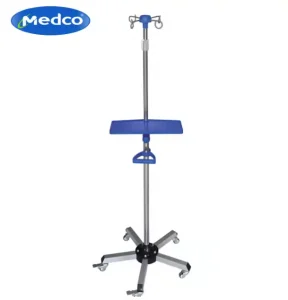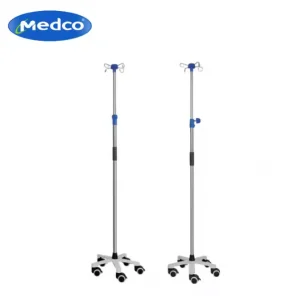
Core Components of an IV Drip Set
Identification of basic components and functions that need to be known before starting to understand the IV drip set and its method of use. All these component works together to provide efficient and safe treatment for patients. A good understanding of these factors is imperative for healthcare workers as they prepare to administer parenteral therapy.
Primary Components
Tubing
The tubing of an IV drip set is the main line through which fluids are administered; it connects from the IV bag and hangs down to where it enters the vascular access site. The tubing is generally more flexible, which allows the fluid to flow smoothly, and often transparent, providing ease in monitoring appropriate fluid level and flow rate. The tube length may be longer or shorter based on the clinical environment and the distance of the patient from the fluid bag. The tubing can also easily connect and disconnect from different infusion devices.
Drip Chamber
Therefore, the drip chamber is part of an IV drip set and performs specific functions – to control the rate of flow and a visual guide for how much fluid has been administered. This meticulous component provides practitioners with a method to monitor the infusion of fluids via a drop-per-minute observation. It is important to have a correctly calibrated drip chamber in order to provide the patient with the required quantity of fluids over a set period of time. Finally, the drip chamber is an important piece of equipment from a safety and efficiency perspective in IV therapy.
Roller Clamp
Roller clamp: This is a part of the tubing of the IV drip set used to control the rate at which fluid flows. When we roll the clamp up or down from that particular level attached to the tubing, it controls how much fluid and what amount enters into the blood circulation of a patient. Such control is especially important in treatment situations where precise dosages are crucial, such as critical care environments. As a result, the roller clamp is an important part of controlling how efficiently IV administration can be.
Injection Port
Injection port: It is an important part of an IV drip set which allows the healthcare professional to inject more medicines directly into the intravenous line. This also makes the IV drip set more versatile, as it allows other medications to be added and given at once without needing a new IV access site. The injection port usually has a self-sealing function to keep away from wider pollution. Adequate Knowledge of the Purpose & Correct Utilization of Injection Ports is Essential for Medical Personnel in Intravenous Therapy Management.
Auxiliary Components
Y-Site
A Y-site, or Y-connector is an external component that allows for the addition of several IV medications/fluids to one line. This connection enables the administration of supplementary therapeutics concurrently with the primary infusion without interfering with it, thereby optimizing intravenous therapies. The Y-site is constructed with backflow-preventing valves to keep the patient safe from cross-infusion. Healthcare professionals who deal with the complex treatment protocols in which a Y-site is essential need to understand its role.
Flow Regulator
Flow Regulator: An auxiliary component that creates more controllability over output flow as allows the infuser to manually change the setting of flow. This tool is important as it makes sure the intravenous medications and fluids are being delivered at the prescribed rate, especially in case of very precise dosages. Moreover, it is also one of the important components in preventing complications related to over-infusion or under-infusion. Healthcare providers must know how the flow regulator works to make sure they perform safe and effective IV therapies.
Medco is a prominent supplier in the area of medical equipment which provides IV drip sets and accessories that are efficient, individual-specific, and highly functional in clearing the various needs of healthcare providers to administer fluids along with enhancing safety by providing essential features too.
Materials and Construction

The safety and efficiency of the product also largely depend on the materials used in making IV drip sets. Knowledge of these materials aids in IV drip set selection by healthcare providers according to patient requirements. The materials selected usually trade between performance, safety, and comfort for the infusion.
Types of Materials Used
PVC (Polyvinyl Chloride)
Standard IV drip sets are primarily polyvinyl chloride (PVC), a ubiquitous and well-utilized plastic material that offers pliability as well as strength. PVC is a versatile material that is commonly used for IV tubing and components due to its ability to withstand fluid infusion pressures. At the same time, its use has also raised questions of safety due to potential toxicity risk, especially through exposure of patients to phthalates used in PVC products. Providers should be cognizant of these factors in choosing IV drip sets for patients.
DEHP-Free Options
As concern regarding the safety risks of traditional PVC IV drip sets, there are presently more DEHP-free options available on the market. These replacements eliminate the necessity of using di(2-ethylhexyl) phthalate (DEHP), one of the most often used plasticizers that have been associated with health risks. IV drip sets that are DEHP-free still perform the same functions while ensuring patient safety. With increasing awareness of such alternatives, healthcare practitioners should consider DEHP-free IV drip sets to mitigate potential exposure risks.
Sterility and Safety Measures
Considering that the IV drip sets are usually sterile; any kind of calibration can lead to serious infections and untoward incidents in patients. Most manufacturers implement stringent sterilization procedures and safety measures during production. Thus, IV drip sets make their way to the hospitals without any contaminants. Best practices also lie with the healthcare providers who have to handle and prepare IV sets in such a way that sterility is preserved. Ongoing education about infection control practices should occur for all healthcare providers who are involved in intravenous therapy.
ConclusionUnderstanding the core components of an IV drip set—its primary and secondary elements, materials that make up the IV drip set disposable parts of it, and safety features, is a key aspect for healthcare practitioners in order to administer effective intravenous therapeutics. By knowing these components, practitioners are aware of how to provide top-quality care while minimizing possible complications brought upon by setting up their intravenous treatments.
Conclusion: Enhancing Medical Efficiency with Quality Equipment
Why Choose Medco?
When choosing an IV drip set or any medical equipment, there is no compromise on quality, safety, and innovation; therefore, select your supplier very wisely. Medco has made its name in the healthcare sector by offering a range of medical supplies to improve patient outcomes. Medco is committed to upholding high safety and quality standards, allowing healthcare providers access to more reliable products to enhance medical treatment administration.
Overview of Medco Products
Medco supplies a variety of products to suit the needs of healthcare professionals.
Diagnostic Instruments
Medco offers a wide range of diagnostic tools that are considered necessary for proper patient evaluation and follow-up. These tools are meant to help health professionals get relevant information related to the particular medical well-being of a patient. Now Instruments like blood pressure monitors, thermometers, and pulse oximeters are meticulously made due to the requirements of being used every day in various clinical environments. In addition, the most important aspect is that Medco puts significant emphasis on reliability and ease of use so that practitioner can operate these devices very well in their daily routines.
Other Medical Supplies
Apart from IV drip sets and diagnostic instruments, Medco also supplies a range of medical devices that assist in bringing well-rounded treatment to the patients. These include wound care, surgical instruments, personal protective equipment (PPE), and so on. All of these products make Medco toys a standard for quality assuring the safety of materials and performance specifications. Medco delivers diverse medical equipment supplies to health professionals so they can meet various clinical needs and provide the best care possible for their patients when addressing them.




